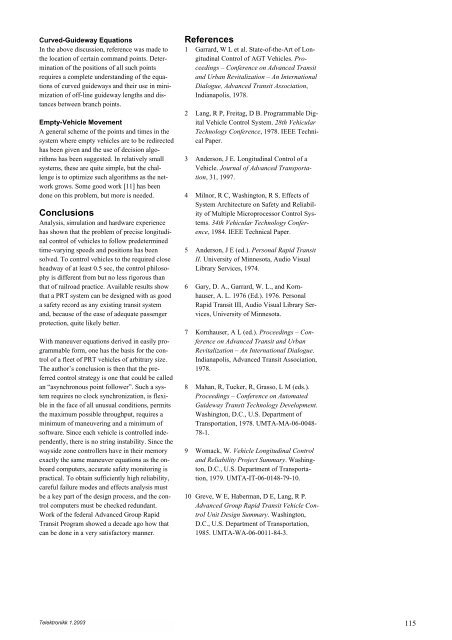Intelligent Transport Systems - Telenor
Intelligent Transport Systems - Telenor
Intelligent Transport Systems - Telenor
Create successful ePaper yourself
Turn your PDF publications into a flip-book with our unique Google optimized e-Paper software.
Curved-Guideway Equations<br />
In the above discussion, reference was made to<br />
the location of certain command points. Determination<br />
of the positions of all such points<br />
requires a complete understanding of the equations<br />
of curved guideways and their use in minimization<br />
of off-line guideway lengths and distances<br />
between branch points.<br />
Empty-Vehicle Movement<br />
A general scheme of the points and times in the<br />
system where empty vehicles are to be redirected<br />
has been given and the use of decision algorithms<br />
has been suggested. In relatively small<br />
systems, these are quite simple, but the challenge<br />
is to optimize such algorithms as the network<br />
grows. Some good work [11] has been<br />
done on this problem, but more is needed.<br />
Conclusions<br />
Analysis, simulation and hardware experience<br />
has shown that the problem of precise longitudinal<br />
control of vehicles to follow predetermined<br />
time-varying speeds and positions has been<br />
solved. To control vehicles to the required close<br />
headway of at least 0.5 sec, the control philosophy<br />
is different from but no less rigorous than<br />
that of railroad practice. Available results show<br />
that a PRT system can be designed with as good<br />
a safety record as any existing transit system<br />
and, because of the ease of adequate passenger<br />
protection, quite likely better.<br />
With maneuver equations derived in easily programmable<br />
form, one has the basis for the control<br />
of a fleet of PRT vehicles of arbitrary size.<br />
The author’s conclusion is then that the preferred<br />
control strategy is one that could be called<br />
an “asynchronous point follower”. Such a system<br />
requires no clock synchronization, is flexible<br />
in the face of all unusual conditions, permits<br />
the maximum possible throughput, requires a<br />
minimum of maneuvering and a minimum of<br />
software. Since each vehicle is controlled independently,<br />
there is no string instability. Since the<br />
wayside zone controllers have in their memory<br />
exactly the same maneuver equations as the onboard<br />
computers, accurate safety monitoring is<br />
practical. To obtain sufficiently high reliability,<br />
careful failure modes and effects analysis must<br />
be a key part of the design process, and the control<br />
computers must be checked redundant.<br />
Work of the federal Advanced Group Rapid<br />
Transit Program showed a decade ago how that<br />
can be done in a very satisfactory manner.<br />
Telektronikk 1.2003<br />
References<br />
1 Garrard, W L et al. State-of-the-Art of Longitudinal<br />
Control of AGT Vehicles. Proceedings<br />
– Conference on Advanced Transit<br />
and Urban Revitalization – An International<br />
Dialogue, Advanced Transit Association,<br />
Indianapolis, 1978.<br />
2 Lang, R P, Freitag, D B. Programmable Digital<br />
Vehicle Control System. 28th Vehicular<br />
Technology Conference, 1978. IEEE Technical<br />
Paper.<br />
3 Anderson, J E. Longitudinal Control of a<br />
Vehicle. Journal of Advanced <strong>Transport</strong>ation,<br />
31, 1997.<br />
4 Milnor, R C, Washington, R S. Effects of<br />
System Architecture on Safety and Reliability<br />
of Multiple Microprocessor Control <strong>Systems</strong>.<br />
34th Vehicular Technology Conference,<br />
1984. IEEE Technical Paper.<br />
5 Anderson, J E (ed.). Personal Rapid Transit<br />
II. University of Minnesota, Audio Visual<br />
Library Services, 1974.<br />
6 Gary, D. A., Garrard, W. L., and Kornhauser,<br />
A. L. 1976 (Ed.). 1976. Personal<br />
Rapid Transit III, Audio Visual Library Services,<br />
University of Minnesota.<br />
7 Kornhauser, A L (ed.). Proceedings – Conference<br />
on Advanced Transit and Urban<br />
Revitalization – An International Dialogue.<br />
Indianapolis, Advanced Transit Association,<br />
1978.<br />
8 Mahan, R, Tucker, R, Grasso, L M (eds.).<br />
Proceedings – Conference on Automated<br />
Guideway Transit Technology Development.<br />
Washington, D.C., U.S. Department of<br />
<strong>Transport</strong>ation, 1978. UMTA-MA-06-0048-<br />
78-1.<br />
9 Womack, W. Vehicle Longitudinal Control<br />
and Reliability Project Summary. Washington,<br />
D.C., U.S. Department of <strong>Transport</strong>ation,<br />
1979. UMTA-IT-06-0148-79-10.<br />
10 Greve, W E, Haberman, D E, Lang, R P.<br />
Advanced Group Rapid Transit Vehicle Control<br />
Unit Design Summary. Washington,<br />
D.C., U.S. Department of <strong>Transport</strong>ation,<br />
1985. UMTA-WA-06-0011-84-3.<br />
115
















